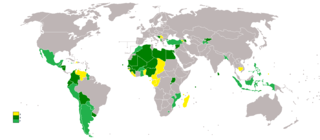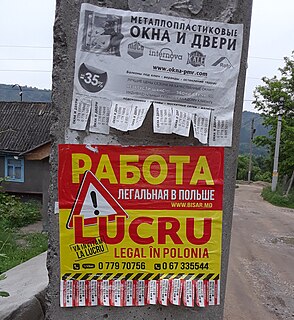Related Research Articles

Human migration involves the movement of people from one place to another with intentions of settling, permanently or temporarily, at a new location. The movement often occurs over long distances and from one country to another, but internal migration is also possible; indeed, this is the dominant form of human migration globally. People may migrate as individuals, in family units or in large groups. There are four major forms of migration: invasion, conquest, colonization and emigration/immigration.
An economic migrant is someone who emigrates from one region to another, including crossing international borders, seeking an improved standard of living, because the conditions or job opportunities in the migrant's own region are insufficient. The United Nations uses the term migrant worker.
Hukou is a system of household registration used in mainland China. The system itself is more properly called "huji", and has origins in ancient China; hukou is the registration of an individual in the system. A household registration record officially identifies a person as a permanent resident of an area and includes identifying information such as name, parents, spouse and date of birth. A hukou can also refer to a family register in many contexts since the household register is issued per family, and usually includes the births, deaths, marriages, divorces, and moves, of all members in the family.

A migrant worker is a person who either migrates within their home country or outside it to pursue work. Migrant workers usually do not have the intention to stay permanently in the country or region in which they work.

The International Convention on the Protection of the Rights of All Migrant Workers and Members of Their Families is a United Nations multilateral treaty governing the protection of migrant workers and families. Signed on 18 December 1990, it entered into force on 1 July 2003 after the threshold of 20 ratifying States was reached in March 2003. The Committee on Migrant Workers (CMW) monitors implementation of the convention, and is one of the seven UN-linked human rights treaty bodies.

A remittance is a transfer of money, often by a foreign worker to an individual in their home country. Money sent home by migrants competes with international aid as one of the largest financial inflows to developing countries. Workers' remittances are a significant part of international capital flows, especially with regard to labor-exporting countries.
Chain migration is a term used by scholars to refer to the social process by which migrants from a particular town follow others from that town to a particular destination. The destination may be in another country or in a new location within the same country.
Chinese Jamaicans are Jamaicans of Chinese ancestry, which include descendants of migrants from China to Jamaica. Early migrants came in the 19th century; there was another wave of migration in the 1980s and 1990s. Many of the descendants of early migrants have moved abroad, primarily to Canada and the United States. Most Chinese Jamaicans are Hakka and many can trace their origin to the indentured Chinese laborers who came to Jamaica in the mid-19th to early 20th centuries.

Circular migration or repeat migration is the temporary and usually repetitive movement of a migrant worker between home and host areas, typically for the purpose of employment. It represents an established pattern of population mobility, whether cross-country or rural-urban. There are several benefits associated with this migration pattern, including gains in financial capital, human capital, and social capital. There also costs associated with circular migration, such as brain drain, poor working conditions, forced labor, and the inability to transfer acquired skills to home economies. Socially, there are strong connections to gender, health outcomes, development, poverty, and global immigration policy.
Internal migration in the People's Republic of China is one of the most extensive in the world according to the International Labour Organization. This is because migrants in China are commonly members of a floating population, which refers primarily to migrants in China without local household registration status through the Chinese Hukou system. In general, rural-urban migrant workers are most excluded from local educational resources, citywide social welfare programs and many jobs because of their lack of hukou status. Migrant workers are not necessarily rural workers; they can simply be people living in urban areas with rural household registration.
The presence of Cape Verdeans in Italy dates back to the 1960s.
Immigration to Europe has a long history, but increased substantially in the later 20th century. Western Europe countries, especially, saw high growth in immigration after World War II and many European nations today have sizeable immigrant populations, both of European and non-European origin. In contemporary globalization, migrations to Europe have accelerated in speed and scale. Over the last decades, there has been an increase in negative attitudes towards immigration, and many studies have emphasized marked differences in the strength of anti-immigrant attitudes among European countries.
Prior to 1994, immigrants from elsewhere faced discrimination and even violence in South Africa. After majority rule in 1994, contrary to expectations, the incidence of xenophobia increased. Between 2000 and March 2008, at least 67 people died in what were identified as xenophobic attacks. In May 2008, a series of attacks left 62 people dead; although 21 of those killed were South African citizens. The attacks were motivated by xenophobia. In 2015, another nationwide spike in xenophobic attacks against immigrants in general prompted a number of foreign governments to begin repatriating their citizens. A Pew Research poll conducted in 2018 showed that 62% of South Africans viewed immigrants as a burden on society by taking jobs and social benefits and that 61% of South Africans thought that immigrants were more responsible for crime than other groups. Between 2010 and 2017 the immigrant community in South Africa increased from 2 million people to 4 million people. The proportion of South Africa's total population that is foreign born increased from 2.8% in 2005 to 7% in 2019, according to the United Nations International Organization for Migration, in spite of widespread xenophobia in the country. This made South Africa the largest recipient of immigrants on the African continent in 2019.
There is a significant population of Zimbabweans in South Africa, making up South Africa's largest group of foreign migrants. Estimates of their numbers range from one to five million.
Chinese people in the Netherlands form one of the largest overseas Chinese populations in continental Europe. In 2018 official statistics showed 92,644 people originating from the People's Republic of China (PRC) and Republic of China (ROC), or people with at least one such parent. However, these statistics do not capture the whole size of the Chinese community, which since its earliest days has included not just migrants from China, but people of Chinese ethnicity drawn from among overseas Chinese communities as well.

Migration of Chinese people in Ghana dates back to the 1940s. Originally, most came from Hong Kong; migration from mainland China began only in the 1980s. Although an exact number is not clear, one unsubstantiated speculation is that the Chinese living in Ghana might number to be as extremely high as nearly 700,000 people. This would however mean that an impossible 2,4% of the people in Ghana are of Chinese heritage. Furthermore, a careful examination of the cited documents does not yield a validation of the above-estimated number; and in any case, it would in the interest of accuracy be important to critically examine how, and on what basis the estimated numbers were arrived at. If this figure were to be correct, it would mean that there are more Chinese people living in Ghana than anywhere else in Sub-Saharan Africa including South Africa which reportedly has the highest Chinese population on the African Continent. Notably, The China Africa Research Initiative at Johns Hopkins University School of Advanced International studies https://www.sais.org cites the total number of Chinese workers in Africa in 2018 as 201,057 as per the National Bureau of Statistics of China which is corroborated by other sources such as The Almanac Of China's Foreign Economic Relations and Trade, and The China Annual Bulletin Of Statistics Of Contracted Projects. This figure indicates a steady decline from the previous years 2015-2017 but however, ostensibly does not account for informal migrants such as traders and shopkeepers.
Chinese people in Kyrgyzstan have been growing in numbers since the late 1980s. 2008 police statistics showed 60,000 Chinese nationals living in the country. However, the 2009 census showed just 1,813 people who declared themselves to be of Chinese ethnicity.
The number of Chinese people in Namibia has grown tremendously since independence.

Jørgen Carling is a Norwegian researcher specializing on international migration. He holds a PhD in Human Geography from the University of Oslo and is Research Professor of Migration and Transnationalism Studies. Carling has worked at the Peace Research Institute Oslo (PRIO) since 2002, where he has been Research Director since 2012.
Women migrant workers from developing countries engage in paid employment in countries where they are not citizens. While women have traditionally been considered companions to their husbands in the migratory process, most adult migrant women today are employed in their own right. In 2017, of the 168 million migrant workers, over 68 million were women. The increase in proportion of women migrant workers since the early twentieth century is often referred to as the "feminization of migration".
References
- 1 2 3 4 5 Haugen, Heidi Østbø (July 4, 2005). "On the edge of the Chinese diaspora:The surge of baihuo business in an African city". Ethnic and Racial Studies. 28 (4): 639–662. doi:10.1080/01419870500092597. S2CID 144205441.
- ↑ "In a World on the Move, a Tiny Land Strains to Cope". New York Times. June 24, 2007.